Holland, William Langford (McKechnie Section 3)
See also Section Four
A profilist and miniaturist recorded by Jackson (Dictionary). Long and Foskett. Though Holland describes himself on his trade label as 'Portrait and Miniature Painter' it is uncertain whether the miniatures which he was offering were the highly skilled full or three-quarter work or the simpler profiles in colour. We know, however, that Holland received a professional training: Strickland mentions that he studied at the schools of the Dublin Society and won prizes there in 1774 and 1776 and a medal in 1779. By then (in 1777), he had exhibited three crayon drawings at the Society of Artist in William Street. These are his only recorded exhibited works.
Jackson states that Holland worked for some time at 12 Suffolk Street, Dublin, as a painter of profiles on glass, for which he charged seven shillings each. This phase was probably during the early 1780s, since an advertisement in a Dublin newspaper (dating from 1786) gives a higher price than this and gives a different address (that is, 46 Capel Street). Two passages in this advertisement are significant 'Most striking likenesses from one to five guineas each' and 'profiles à la Marlborough painted on glass, being the invention of a foreign gentleman who has brought this art to a perfection never before known, in this or any other country. Elegant gilt frames furnished: price of both frames and profiles being so moderate as half a guinea.' We know from an advertisement published in Aris' Birmingham Gazette in June 1785 by William Hamlet the elder (q.v.) that Hamlet had invented a device for taking profiles which he was offering for sale The same advertisement tells us that Hamlet had already visited Ireland, probably in spring 1785, and in the entry on Hamlet I discuss the possibility that he was of French extraction (and therefore 'a foreign gentleman'). It seems likely, therefore, that it was indeed Hamlet who sold the 'invention mentioned in the advertisement to Holland (and also to C. H. Sandhegan, q.v., who may have been working in Dublin in 1785).
Both Holland and Sandhegan use on their trade labels the puzzling phrase 'à la Marlborough'; both also quote the French phrase, 'dans l'absence du réel, l'ombre me contente' If both artists bought from the 'foreigner a device for taking silhouettes, then the lid of the box in which it was contained may have borne this inscription (although Hamlet himself does not appear to have used the phrase on his trade labels or in his few extant advertisements). It is also possible that the device itself was called the 'Marlborough'. after the street in Dublin. Marlborough Street did exist as long ago as the 1780s, and Holland and Sandhegan may have worked in it for a short period. Since the advertisement by Holland which contains the French phrase was issued from Capel Street, he must have worked in Marlborough Street (if at all) after he had left Suffolk Street and before he worked in Capel Street. Strickland tells us that in 1787 Holland published an advertisement in Kilkenny, again mentioning the 'machine originated by a foreign gentleman who had brought the art to a perfection never before known' and describing himself as 'Miniature Painter à la Marlborough'.
Surviving silhouettes by Holland appear to date from the late 1780s or early 1790s and were probably all taken in Dublin. Judging by the sitters dress, it is doubtful whether any are early enough to have been taken during Holland's visit to Kilkenny.
Jackson noted that she had seen a group of nine portraits in silhouette of one family; she writes that 'on several of these the price of £5/5/- was written in the space left for that purpose on the labels'. Although it is so faint that it is barely legible, this appears to be the price written at the foot of Holland's Trade Label No. 2. It was an exorbitant price to charge for this type of work during the 1780s and one can only wonder what price he would have charged for portrait miniatures. Possibly the arrival in Dublin in March 1790 of J. Thomason, who offered work on plaster at a much lower figure, put an end to Holland's practice in the city.
Holland painted on the under surface of flat glass, using what appears to be black water-colour. He did not use a fingerprinted base. Little detail is shown on the main body of the profile, except (in some cases) on the buffon which was worn over the bosom by fashionable women at the time the artist was working. Buffons, men's or boys' shirt-frills and women's hats are often indicated by transparency. Shirt-frills are almost always painted with a square formation showing at the edge of the frill (only one of the illustrated examples is an exception). Holland may have used a needle to indicate some of the high-lighting on transparent parts of his work, and to indicate hair (which, bearing in mind Holland's artistic training and outrageous prices, is less well painted than might be expected).
1082
Holland either used a bust-line finish with a double concavity (formed by a dip at the junction of the arm with the rest of the profile; compare the later work of Walter Jorden) or a simple convexity /concavity finish.
Most of Holland's silhouettes are backed with silk or satin (originally white, but now usually brownish from age). The absence of such a backing does not necessarily disprove the attribution of an example to Holland, since it may have deteriorated over the years and then been removed.
On his trade label Holland uses the words 'with a composition in Watercolour much Superior to any other yet Attempted in Oil Colour on Glass'. How many glass painters did use oil colour is not known, but Holland's phrase does suggest that some other Irish artists may have used this medium. (I have discussed this point in Chapter Three.) The words 'a composition in Watercolour' might suggest that the artist used water-colour pigment mixed with some substance such as gum arabic especially for work on glass, for the text continues 'in Watercolour on plaister of Paris' (suggesting that Holland used ordinary water-colour for work on plaster). I have not seen a silhouette by Holland painted on plaster, but the difference in the density of the black between one of his silhouettes on glass and one on plaster (should an example come to light) would be of interest.
Most of Holland's profiles are in oval hammered brass frames, often with a leaf or beaded edge.
Two trade labels are known. No. 1 reads: 'Profile Shades/A LA MARLBOROUGH/Painted on Glass/By/Mr. HOLLAND/MINIATURE PAINTER/DUBLIN/146, Capel Street.' (The last line was added in longhand.) Presumably this label was used c. 1786, and No. 2 (illustrated) was used later. No. 2 is worded as follows:
MINIATURE
Profile Shade Likenesses
A LA MARLBOROUGH
Painted upon glass
By Wm. L. HOLLAND
Portrait and Miniature Painter
DUBLIN
With a composition in Watercolour
much Superiour to any other yet
Attempted in Oil Colour on Glass
in Watercolour on plaister of Paris,
this Method is Intirely New and
executed in the highest Style
Of Perfection.
In a curve round the top of the label is the phrase: 'Dans L'absence du Réel L'ombre me contente'. At the foot the price of '£5/5/-', written in pencil, is just legible.
Ills. 232, 1082-1087
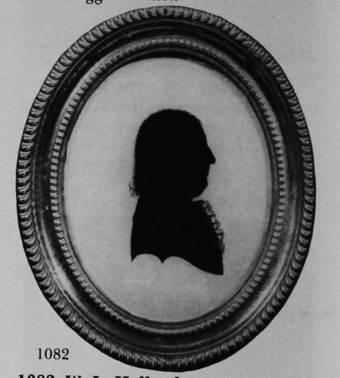
Unknown man
Silhouette painted on flat glass, backed with satin
c. 1788
3 ¼ x 2 ¾ in./83 x 70mm.
Trade Label No. 2
Frame: oval, hammered brass
The bust-line finish has a characteristic double concavity. The square finish of the sitter’s shirt-frill, also typical of Holland’s work, is absent.
J. A. Pollak collection
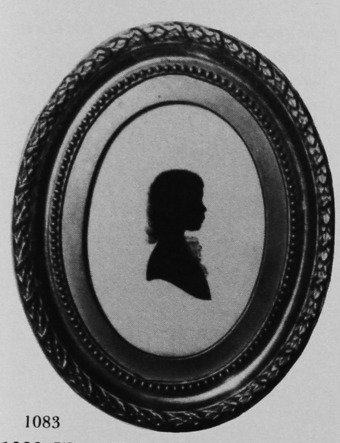
Unknown boy
Silhouette painted on flat glass, backed with satin
c. 1788-90
3 x 2 ½ in./77 x 64mm.
formerly in Mrs Nevill Jackson’s collection, this silhouette has been exhibited at the Victoria and Albert Museum, London.
By courtesy of Lieutenant-Colonel P. F. White, O.B.E
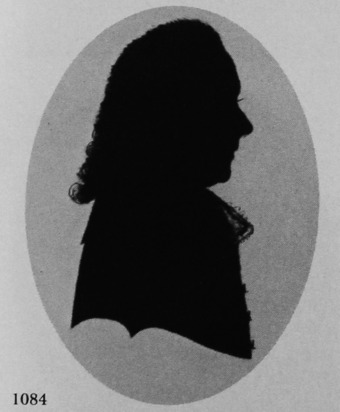
Unknown man
Silhouette painted on flat glass
c. 1788-90
Trade Label No. 2
Frame: oval, hammered brass
The sitter’s long bob wig may indicate that he is a cleric.
British Museum, Banks collection
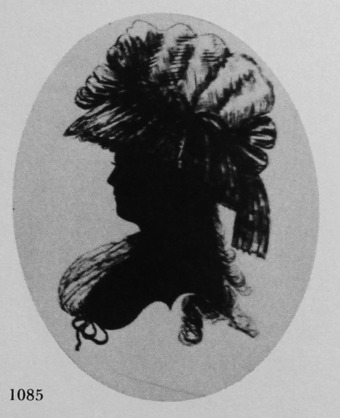
Unknown woman
Silhouette painted on flat glass
c. 1788-90
Frame: oval, hammered brass
The sitter of this silhouette may have been the wife of the sitter of the companion silhouette (1084). The date is suggested by her soft-crowned outdoor hat, tilted backwards.
British Museum, Banks collection

Unknown boy
Silhouette painted on flat glass, backed with white satin
c. 1790
3 ¼ x 2 ¾in./83 x 70mm.
Frame: oval, hammered brass.
J. A. Pollak collection
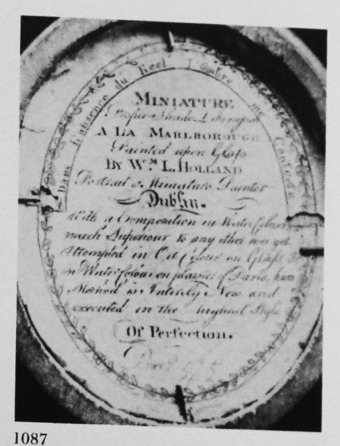
Trade Label of W. L. Holland.
British Museum, Banks collection
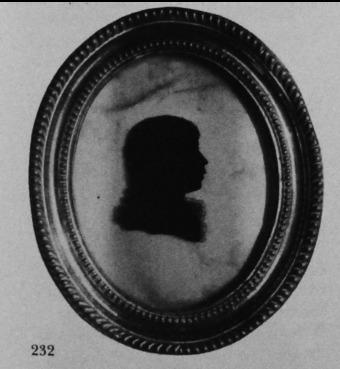
Unknown boy (perhaps twelve years old)
Silhouette by W. L. Holland, mid-or-late 1780s.
costume dating points
The hair, permitted to grow to the shoulders.
Even on this almost plain black silhouette, the customary fringe over the forehead can be seen.
This boy is probably dressed in man’s clothes, since the square shape in front probably indicates a man’s shirt-frill, often shown by Holland in this way.
Holborne of Menstrie Museum, Bath, No. M.121
SECTION THREE
